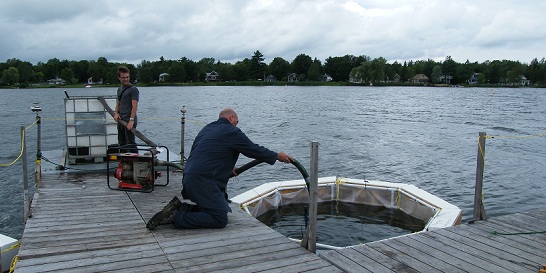
To restore the highly eutrophicated Saint-Augustin Lake and prevent the proliferation of cyanobacteria, Quebec City, QC conducted two field tests to determine the effectiveness of various nutrient control techniques. In the first test, waterborne phosphorus was precipitated in the bottom sediments, which were then covered and hence neutralized. The second test involved precipitating the phosphorus and then pumping out the sediment for treatment and disposal. In both cases, the city assessed the release rate for existing and new sediment, and conducted a technical and socioeconomic assessment, including a preliminary study of environmental impacts. The findings showed that the first method produced better results.
There are few examples of in situ management of sediment-derived phosphorus in Canada. The findings from the pilot project will therefore be invaluable for municipalities faced with similar issues.
Results
| Environmental | Economic | Social |
|
|
|
Challenges
-
This project involved a number of municipal, provincial, federal and private partners, who each had their own agreement models with various obligations and commitments. Reaching an agreement that accommodated the individual stakeholders various constraints was therefore a rather lengthy process.
-
Installing the floating platform also raised numerous issues, specifically anchoring the enclosures at the bottom of the lake. Under the circumstances, the City had to use professional divers.
-
In addition, extreme weather conditions compromised the effectiveness of the platform. Numerous minor repairs were required.
Lessons learned
-
If a complete assessment reveals the presence of various pollutants, control measures for the entire watershed must be put in place. Control measures can then be directly applied to the aquatic ecosystem.
-
The two field tests were conducted only once in each case for three to four months. Also before attempting to restore the entire lake, it is essential to conduct tests in isolated areas for two to three years. The effectiveness of the technologies can therefore be estimated and documented.
-
Municipalities interested in restoring a lake with a similar problem will find an overview of the project in the final report including a description of the pilot project, research findings and test results, a comparative analysis of the remediation measures tested, along with conclusions and recommendations.
-
On the basis of this experience, Quebec City was pleased that it had set up a multidisciplinary committee. Given that the project involved every sphere of sustainable development, the multidisciplinary committee provided a broader perspective and increased the chances of success.
Partners and Collaborators
Project Contact
Alexandre Baker
Environmental Advisor
Environment Department, Water Quality Division
Quebec City, QC
Alexandre.baker@ville.quebec.qc.ca
T. 418-641-6411, ext. 2827
T. 418-641-6556
Want to explore all GMF-funded projects? Check out the Projects Database for a complete overview of funded projects and get inspired by municipalities of all sizes, across Canada.

